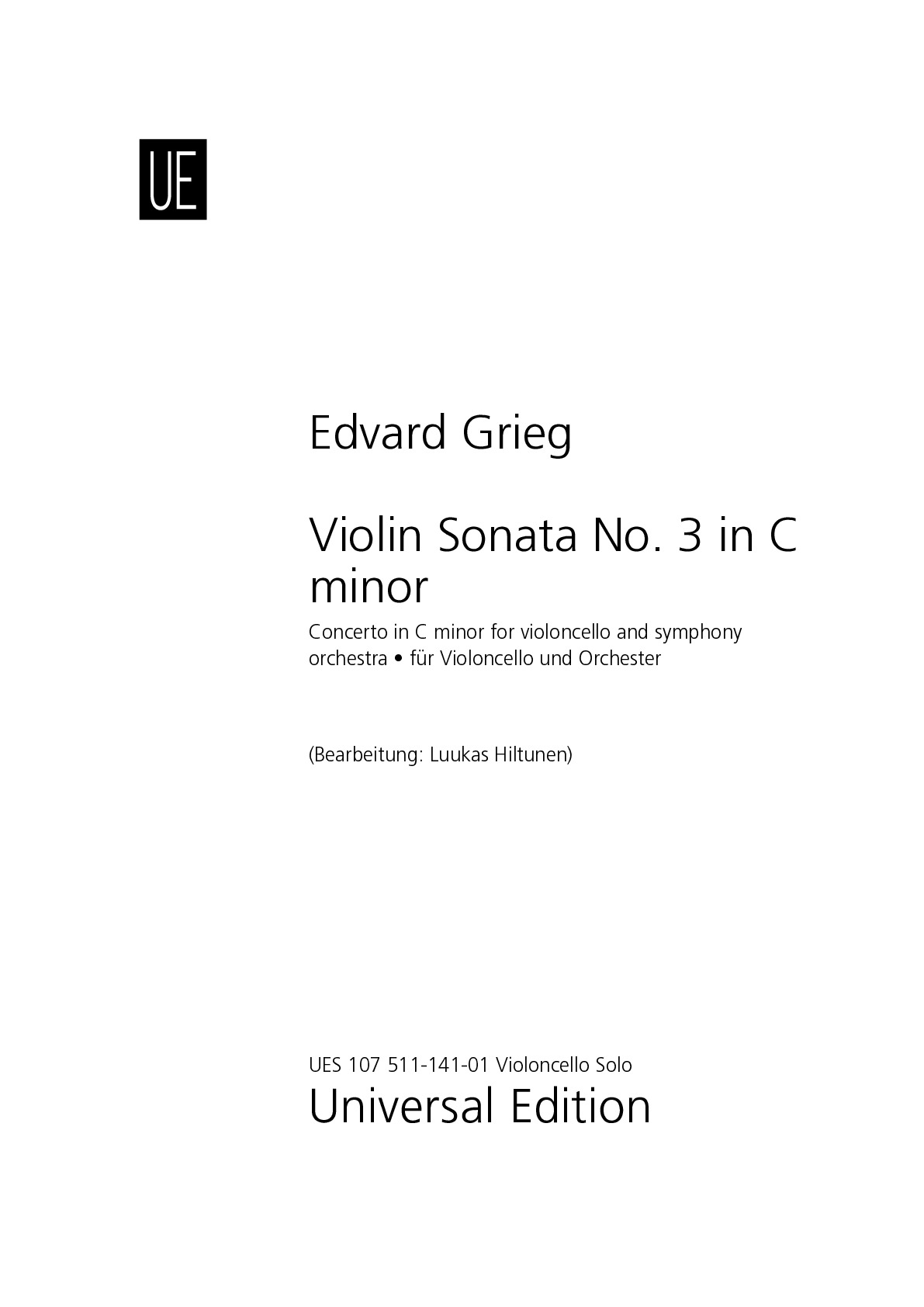.png)
Digital edition
immediately available as PDF
€14.95
Payments:
Shipping:
Edvard Grieg
Violoncello (Violin Sonata No. 3 in C minor)
Bearbeitung: Luukas Hiltunen
UES107511-141-01
Type: Solostimme(n)
Format: 210 x 297 mm
Pages: 28
Digital edition
immediately available as PDF
€14.95
Payments:
Shipping:
Audio preview
Description
The present publication of Mr. Hiltunen's 2018 adaption for violoncello and symphony orchestra of Edvard Grieg's Violin Sonata No. 3 in C minor, Op. 45 as Concerto in C minor for violoncello and symphony orchestra is to celebrate the 180th Anniversary on the birth of Edvard Grieg, the national composer of Norway.
Mr. Hiltunen describes the project as follows:
"The only concerto completed by Edvard Grieg (1843–1907) is for piano and orchestra in A minor (Op. 16), written by the 24-year-old composer in the summer of 1868. The concerto, which was premiered on 3 April 1869 in Copenhagen by Edmund Neupert, is one of his the most known works and is among the most popular of the genre. Strongly influenced by his native land’s folk music, Piano Concerto in A minor is an interesting example on the progress of the composer’s own musical language, providing a fascinating combination of the two.
In the Autumn of 1886 Grieg began sketching the work that turned to be out as his Sonata for Violin and Piano No. 3 in C minor, Op. 45, his final work of the genre. The first performance took place in the following year in Leipzig. Grieg himself was at the piano, the solo part was played by the well-known violinist Adolph Brodsky. Soon the sonata established itself in the standard repertoire and has remained the most popular of the three. Grieg had actually arranged six months earlier the middle movement, Allegretto espressivo, for cello and piano. The movement was at first an independent composition, written as a birthday present for the composer’s brother John Grieg who was a keen amateur cellist, before to be revised for the inclusion to the Violin Sonata. As it was the case with the outer movements, the autograph manuscript, preserved in Bergen Public Library (Norwegian: Bergen Offentlige Bibliotek), was used as the source for the adaption.
On the point of orchestration the individual layers of the musical palette were forming almost automatically. For instance, in the already mentioned second Allegretto espressivo movement at the beginning, it felt natural to set the accompaniment voices to strings and the lyrical theme to flute in the manner of the opening of Morning Mood from Peer Gynt Suite No. 1. Likewise throughout the whole work, the aim was to be as faithful as possible on the orchestration principles of the composer. Reference works were, in addition to the already mentioned Piano Concerto in A minor and Peer Gynt Suites No. 1 & 2, String Quartet No. 1 in G minor (Op. 27), Sigurd Jorsalfar Suite (Op. 56) and an early Symphony in C minor (EG 119, withdrawn by the composer). Moreover, Grieg himself prepared transcriptions for symphony orchestra of his piano pieces, Four Symphonic Dances (Op. 64) and Lyric Suite (Op. 54, orchestration of four Lyric Pieces). A Bohemian violinist, violist, teacher and composer Hans Sitt (1850–1922) prepared the best-known orchestration of Norwegian Dances (Op. 35, an 1881 work originally for piano duet). Grieg’s own arrangement for string orchestra of his Holberg Suite (Op. 40), originally written for piano, was, in addition to all the above-mentioned works, source for the final tonal presence.
The solo cello part is throughout the second movement Grieg’s. Quite an unusual is his request concerning tuning: the lowest string to be tuned down a step (from C to B). The orchestration has been implemented in a way the soloist is able to play effortlessly all the significant themes and passages, not only in the particular movement but within the entire work, as well.
The remaining movements were much more demanding as regards the solo cello part. It is very unlikely Grieg had had plans to arrange those for cello as the second movement was only prepared to be given as a gift (and moreover most plausibly as a surprising one). Yet because Grieg had adapted the movement in such an idiomatic way, an idea to prepare the whole sonata for cello was a stirring one. Obviously it was necessary to set almost all passages one octave lower in order to maintain playable technique. It was also mandatory to take cello’s natural sonority into account. Fortunately I had an experienced cellist within the process who was providing priceless information on technical possibilities, instructed at the crucial passages on how to prepare a coherent and idiomatic adaption for the remaining movements: my warmest acknowledgements to the cellist Auroora Perttunen for an assistance!
Within the UE publication after five years of its completion, it is hoped the adaption will become part of the established repertoire alongside the composer’s Piano Concerto in A minor so that there to be an alternative concertante work, faithfully prepared to honor the Norwegian master’s cultural heritage and an unparalleled significance on the history of Western classical music".
More information
Type: Solostimme(n)
Format: 210 x 297 mm
Pages: 28

